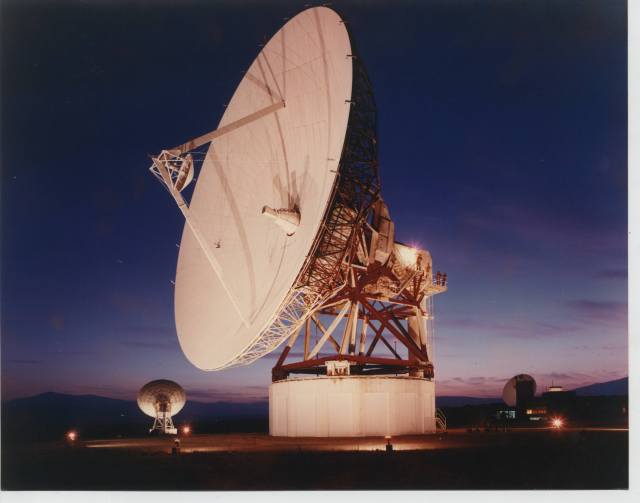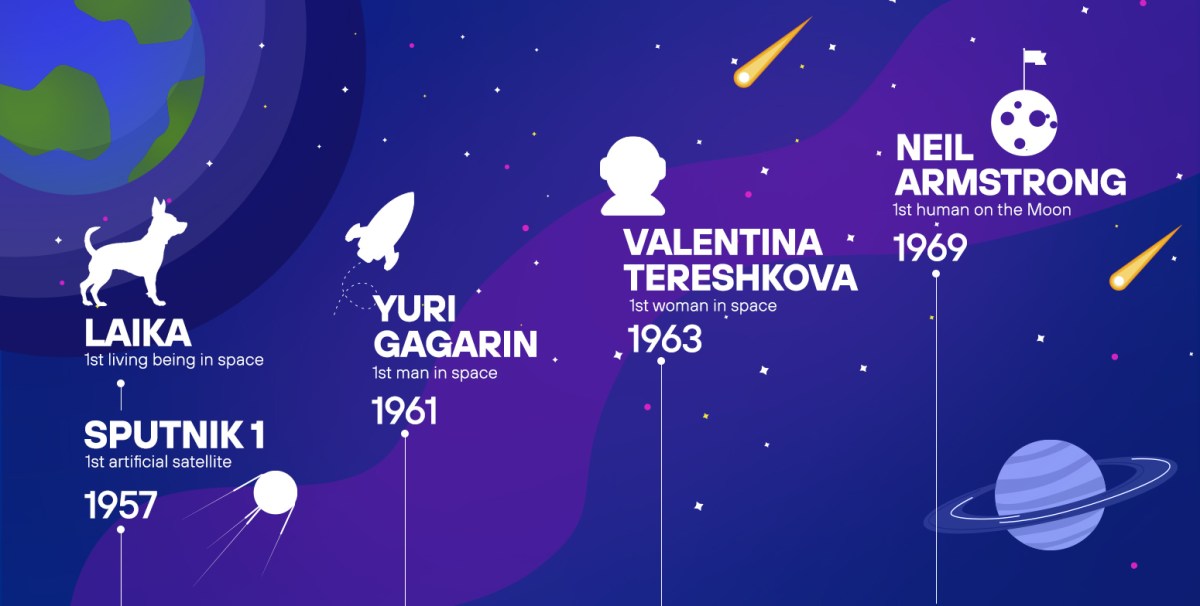In the context of the Cold War, the competition between the Union of Soviet Socialist Republics (USSR) and the United States of America led to a scientific-technological war to conquer space.
A competition in which the first major milestones (such as the first living being, the first man or the first woman in space) were set by the Soviets between the late 1950s and the 1960s, although at the end of this decade the Americans achieved the greatest space event of all: the landing on the moon.
What role did Telefónica play in this important part of human history in the 20th century?
Don’t miss this article on the main dates and most relevant events of the space race.
1957. Sputnik 1: the first artificial satellite
On 4 October 1957, the first artificial satellite in history was sent into space: Sputnik 1. An event that can be seen as the beginning of the space race.
Weighing just 83 kg and with a diameter of 58 centimetres, this aluminium sphere reached a distance of more than 940 kilometres from the Earth’s surface and remained in orbit until 4 January 1958 after circling our planet 1,400 times.
This and the other Sputnik satellites were carried out as part of the International Geophysical Year implemented by the UN between 1957-1958.
1957. Laika: first living thing in space
On board the Sputnik 2 spacecraft, on 3 November 1957, the dog Laika made history by becoming the first living creature to orbit the Earth.
Larger than its predecessor – 4 metres high and two metres in diameter at its base – Sputnik 2 orbited for 162 days with more than 2,500 orbits around the Earth.
However, its illustrious passenger barely lasted a few hours alive due to overheating and stress, although for several years the Soviet authorities gave conflicting accounts of her end.
This stray dog, who went down in posterity as Laika but whose original name was Kudryavka and weighed 5 kilos, had been trained to acclimatise to the cramped dimensions of Sputnik 2.
1961. Yuri Gagarin: first man in space
Soviet pilot and cosmonaut Yuri Alekseyevich Gagarin made history as the first human being to enjoy the view of the Earth from space. On 12 April 1961, aboard the Vostok 1.
After completing one orbit around the Earth and lasting less than two hours, the mission was completed.
In this way, the Vostok programme succeeded in making one of its missions the first to include a manned space flight, anticipating the Mercury programme developed by the United States.
1963. Valentina Tereshkova: first woman in space
Soviet cosmonaut Valentina Vladimirovna Tereshkova, also part of the Vostok programme, became the first woman to travel into space.
On 16 June 1963, aboard Vostok 6, Tereshkova completed 58 Earth orbits, taking almost three days to complete, and landed back on 19 June of the same year.
Another curiosity is that Tereshkova also became the first civilian to fly in space, although she had to be honorarily admitted to the Air Force to become a member of the Cosmonaut Corps.
1965. Aleksei Leonov: first space walk
Much less known than his predecessors or his successors in space milestones, Aleksei Leonov, also a Soviet, made history with the first spacewalk.
The pilot, engineer and cosmonaut made posterity after the first space walk, an event that took place on 18 March 1965.
On that date, Leonov left the Voskhod 2 spacecraft for 12 minutes – tethered by a five-metre-long rope – where Pavel Beliayev was waiting for him to return, marking another Soviet milestone in the history of the space race.
1966. Venera 3: first landing on another planet
Also with less media coverage than the other events we are reviewing, the Venera 3 spacecraft lifted off on 16 November 1965.
A few months later, on 1 March 1966, the spacecraft reached its goal: to land on the planet Venus. In this way, it became the first terrestrial probe to impact with another planet.
1969. Neil Armstrong: first human on the Moon
Although the Soviet Union had managed to leave its mark on the main milestones of the space race between the 1950s and the 1960s, the great historical event related to it was a goal scored by the United States: the arrival of mankind on the Moon.
An event of such magnitude that it has even led to the creation of International Moon Day, a day that is commemorated every 20 July.
On that day in 1969, Apollo 11 with Michael Collins, Neil Armstrong and Edwin ‘Buzz’ Aldrin reached the Earth’s only natural satellite, the latter two being the ones to set foot on the lunar surface, while Collins was waiting for them in the spacecraft.
It was a historic day that the whole of humanity was watching, with the added incentive that the massive use of television meant that the popularity of the event reached unsuspected heights, and that in some countries it took place on 20 July while in others it was already the 21st.
Telefónica and the Moon
An unforgettable evening for all those who experienced it and in which Telefónica did its bit.
The company’s ground station in the Madrid town of Buitrago del Lozoya, as stated on the company’s centenary website, ‘was soon connected to the NASA tracking station in Robledo de Chavela’, a ‘branch’ in Spain of NASA, which was one of the 20 stations around the world.
However, ‘as fate would have it, during the Apollo XI mission in the summer of 1969, only three of them – Robledo de Chavela, Goldstone in California and Canberra in Australia – were able to maintain constant communication with the spacecraft despite the Earth’s movement’.
Although ‘certain technical setbacks had to be overcome that almost jeopardised the mission, (…) in the end, Telefónica’s engineers – and the American teams involved as well – achieved the optimum connections to facilitate the mission, and not only that: also the possibility of broadcasting on television the historic images of the small step for the most famous man in history’.

1971: first space station and first probe to orbit another planet
The year 1971 saw two milestones, one achieved by the Soviet Union and the other by the USA.
First space station
Saliut 1 was the first space station in history. Launched into low Earth orbit on 19 April 1971 – the same day as Telefónica’s 47th birthday – it remained in orbit for 175 days.
First probe to orbit another planet (Mars)
The Mariner 9 probe – launched on 30 May 1971 – reached Mars on 13 November of the same year, acquiring the status of the first spacecraft not only to orbit Mars but any planet other than Earth.
1975: first cooperative mission
While not the greatest event in the history of the space race, it was of qualitative significance.
In July 1975, the Apollo-Soyuz mission became the first space project between two different nations: on the 15th of that month, each spacecraft left its place of origin and docked two days later.
For more than 40 hours the two spacecraft were docked, at which point the crew members (three Americans and two Soviets) shook hands for the first international handshake in the history of space.









